#Flora and Chloris
Explore tagged Tumblr posts
Text

La Primavera by Sandro Botticelli
#primavera#art#sandro botticelli#renaissance#spring#mythological#venus#mercury#the three graces#flora#chloris#zephyrus#cupid#garden#mythology#gods#europe#european#history#florence#italy#italian#northern italy#allegory#classical mythology#neoplatonism
200 notes
·
View notes
Text









Flora: Roman goddess of flowers and fruit bearing trees. Her festival, Floralia, was celebrated April 28th-May 3rd.
#pagan#deities#polytheism#polytheist#deity#paganism#roman paganism#greek mythology#hellenic polythiest#hellenism#Chloris#Flora#Floralia#moodboard#deity moodboard#religio romana#devotional moodboard#witchy#witchcraft#cottagecore#flowers
31 notes
·
View notes
Note
Neon is angry and wants to know who put her mother in the betting pool on who Jaune will hook up with?
Probably Whistler lol
Whistler: Oh yeah? Well I already got a thousand on my little girl ending up with Blondie!
Flora: A thousand?! Who the hell are you betting with?
Whistler: Everyone!
28 notes
·
View notes
Text
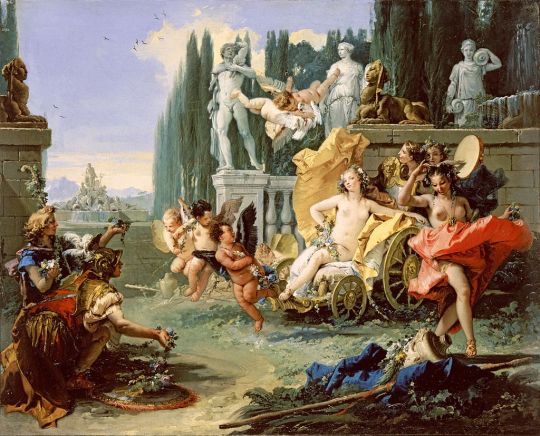
Giovanni Battista Tiepolo
27 notes
·
View notes
Text
I believe in the language of flowers, the floral kingdom makes me happy.
14 notes
·
View notes
Photo

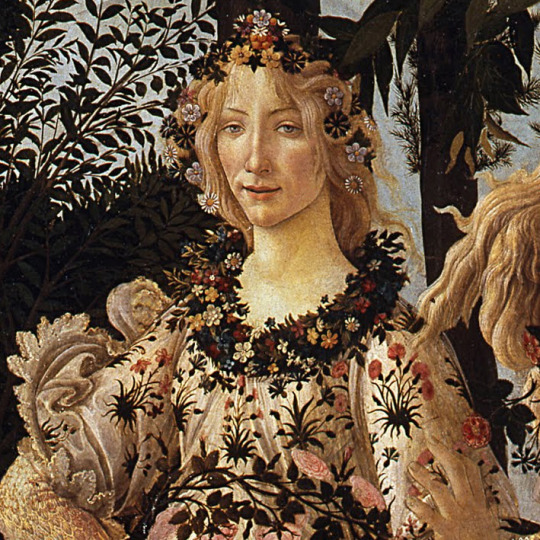
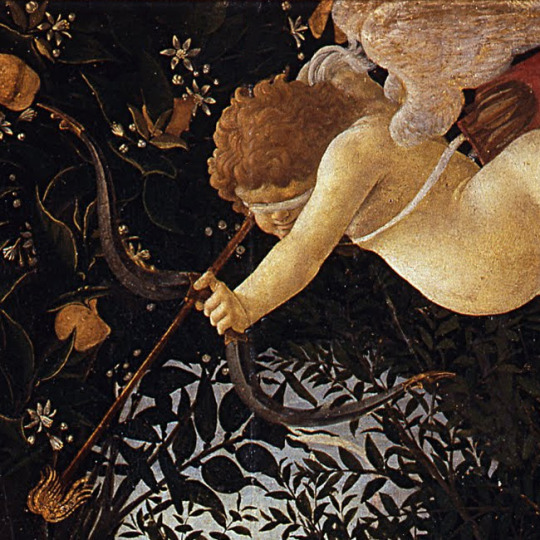
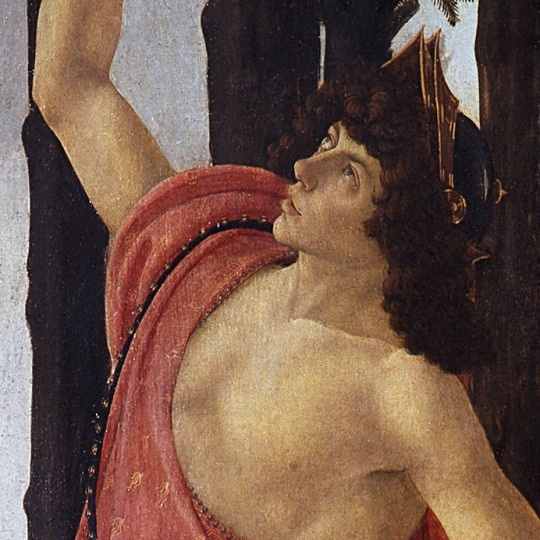

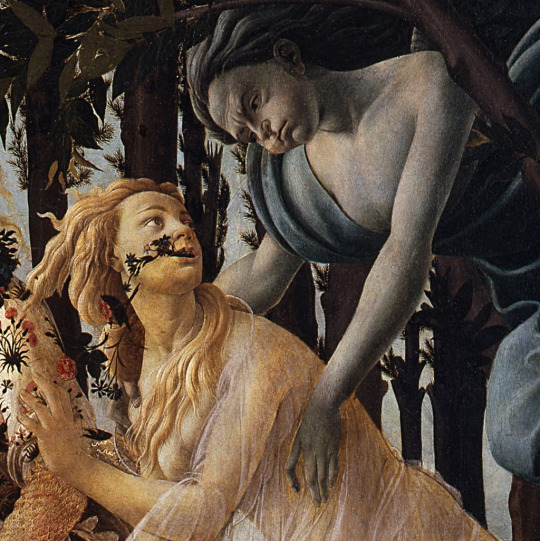
✨ D E T A I L S ✨
Sandro Botticelli Primavera, c. 1480 Tempera grassa on wood
↪ Get this design on a t-shirt, sweatshirt, or notebook 🥀
#sandro botticelli#botticelli#primavera#spring#allegory of spring#italian art#art history#dark academia#light academia#art academia#academia aesthetic#art major#mythology#cupid#venus#flora#chloris#mercury#renaissance#details
8 notes
·
View notes
Text

Chloris was the goddess of flowers in Greek mythology, and was associated with the new growth of spring. The west wind god, Zephyrus, fell in love with her, and abducted her to be his wife. She was later renamed Flora.
Time lapse on my Instagram
instagram
#Chloris#Flora#flora and fauna#greek goddess#greek mythology#fantasy art#roman mythology#roman gods#flower aesthetic#digital art#clip studio paint#artists on tumblr#flower goddess#Instagram
1 note
·
View note
Text
Hannibal and Will reuniting and acknowledging their love in front of the primavera means so much to me actually. The centrepoint of the primavera is the goddess Venus. Chloris the nymph blooms into Flora the goddess at the touch of Zephyr's love, and heralds the coming of spring. The painting is symbolic of all the themes of renewal, new beginnings, and transformative love shared between the both of them. I can't even imagine how Hannibal must have felt in that moment, sat next to the man he loves that he has changed and that changed him in front of the painting that depicted the connection he desperately craved all those years.
534 notes
·
View notes
Text
Hannibal 3x2: Why Botticelli's Primavera? - A painting analysis
ok im only on the second episode of s3 of hannibal so if it turns out in three episodes they debunk this entire post that'll suck.

The first kill of Il Mostro replicates Primavera, specifically Zephyr and the nymph Chloris, who becomes his wife. The flowers out of her mouth -- which Pazzi calls attention to -- symbolizes how Zephyr transforms her into the goddess of Spring.
Primavera is a rather specific choice; especially considering that Zephyr and Chloris are also depicted in Botticelli's "you've-probably-never-heard-of-it-bc-it's-so-niche" work: The Birth of Venus.
Lecter is obsessed with Primavera specifically, going to the museum sketch it almost every day, from what Pazzi recalls.

As a quick refresher (since obviously all of you know all the details of Primavera by heart):
the guy on the far left is Mercury (Hermes, if you're a PJO kid)
the three women dancing are the Three Graces (a symbol of chastity)
the woman in the center is Venus (goddess of love)
blindfolded baby Eros is shooting an arrow at the Three Graces (a disservice to Eros, but that's a topic for another day).
the woman to the left of Chloris is Flora (sometimes called Primavera), the deity that Chloris transforms into.
I. Isolating Zephyr and Chloris: Hannibal's influence on Will
Focusing on Zephyr and Chloris (as Hannibal does), we can interpret Hannibal as Zephyr, the wind god grabbing the fearful nymph Chloris, and transforming her into a spring goddess.
It's established in prior scenes that Hannibal views other people as less-than-human, even referenced to pigs in the prior seasons (see: "he kills in sounders"). Hannibal believes that, in his murders, he is transforming man into god. This reflects his later cannibalistic tendencies; transforming meat into fine dining. Flowers erupt from Chloris's mouth -- she is transformed from the inside out.
A parallel can even be drawn to Will, whose transformation arguably begins after he vomits up Abigail Hobbs' ear and is arrested. Under Hannibal's influence, Will is transforming into Primavera.
II. Carnal vs Divine Love: Will's influence on Hannibal
A popular interpretation of the painting involves the juxtaposition of carnal and divine love (reading right to left). Zephyr attacks Chloris carnally and violently on the far right. In the center sits the goddess of love. The Three Graces, who symbolize Chastity, turn away from carnal love, unknowingly about to be shot by Eros -- a symbol of divine love.
This is Hannibal's character arc!!
Hannibals first killing is represented by carnal love, a deep love for killing for a show of power. He kills because he can.
His first kill in the show, however, is the murder of Cassie Boyle. Art historians Blech and Doliner note that the openings in the trees above Venus are shaped precisely like lungs. And what's one of the first things Hannibal does in the whole show? He took Cassie Boyle's lungs and fed them to Will. Directly beneath the symbol of his first murder, is the goddess of love: Venus. Meeting Will moves Hannibal to the center of the painting, where love appears between the lungs of Cassie Boyle. Kinda gross but it's a show about a cannibal what can you do?
Hugh Dancy -- son of a philosopher, remember? -- refers to the love between Hannibal and Will by the end of the show as platonic love, to which he meant "Plato"-nic love, which in philosophical terms equates now to divine love.
My best prediction for the end of S3 is that Hannibal will transition to the left of the painting, and reach the divine love form of killing -- whatever that's going to look like.
#not sure why hannibal included the orange trees i thought primavera was just in an orange grove bc the Medici family commissioned the piece#maybe he just likes oranges#this is my first nonshitpost pls be nice#hannibal#will graham#nbc hannibal#hannigram#art history#primavera#sandro botticelli#i spent way too long on this#dark academia kinda
130 notes
·
View notes
Text

Flora Caressed by Zephyr
Artist: François Gérard (French, 1770-1837)
Date: 1802
Medium: Oil on canvas
Collection: Museum of Grenoble, Grenoble, France
Description
Ovid tells this myth in Book V of the Fasti; Flora herself explains to the poet who she is, what her attributes and accomplishments are, and justifies the games dedicated to her in Rome. Originally, Flora, or Chloris among the Greeks, is a nymph from the Fortunate Isles known for her great beauty. One spring, Zephyr, god of the West Wind, sees her and immediately falls madly in love with her. He pursues her, then ends up kidnapping her and marrying her. Zephyr then offers his wife, who has become a goddess, the "sovereignty of flowers". Flora tells the poet Ovid that she has set herself the mission of classifying all species of flowers, without succeeding because of their number. Linked to the city of Rome, the goddess is offered every year, between the end of April and the beginning of May, sumptuous festivals that end with games: the Floralia . Associated with spring, with flowers of course, with youth and beauty, the cult of Flora in Rome consists more concretely in the protection of the flowering of agricultural plants.
#roses#peonies#daisies#asters#pansies#mythological art#painting#oil on canvas#fine art#literature#ovid's metamorphoses#flora#zephyr#god of the west wind#goddess#naked figure#mythology#oil painting#francois gerard#french painter#french art#19th century painting#artwork#french culture#european art
66 notes
·
View notes
Text
my headcanons for genshin characters' full names (plus some canon ones lol) ^-^
Travelers:
Aether Sirius Viator
Lumine Spica Viator
Paimon Alycone Merope
Mondstadt:
Albedo Erich Kreideprinz
Amber Ida Hasenkamp-Xia
Astrologist Mona Magdalena Megistus
Barbara “Barbie” Liselotte Pegg
Bennett Anselm Mallory
Dahlia Bram Batz
Diluc Bastian Ragnvindr
Diona Dafni Kätzlein
Eula Babette Lawrence
Fischl von Luftschloss Narfidort
Jeanette “Jean” Elke Gunnhildr
Kaeya Rivaan Alberich / Ragnvindr
Klee Käthe Kessler
Lisa Fiorella Minci
Michael “Mika” Clemens Schmidt
Noelle Petra Desroche
Razor Rolf Minci
Rosaria Karoline Nacht
Vanda “Sucrose” Anneliese Hertz
Varka Johann Bahl
Venti Detlef Daiber / Barbatos
Liyue:
Bai Chongyun
Cai Yanfei
Dai Yaoyao
Ding Xiao
Fei Xingqiu
Hu Tao
Huang Zhongli / Morax / Rex Lapis / Deus Auri
Lei Beidou
Lu Xinyan
Luo Ganyu
Luo Shenhe
Luo Xianyun
Mao Xiangling
Xue Baizhu
Xue Qiqi
Yan Yelan
Yao Ningguang
Yip Gaming
Yun Jin
Zhuang Keqing
Inazuma:
Arataki Itto
Kaedehara Kazuha
Kamisato Ayaka
Kamisato Ayato
Koizumi Chiori
Kujou Sara
Kuki Shinobu
Naganohara Yoimiya
Nekoba Kirara
Raiden Ei / Beelzebul
Raiden Shogun
Sangonomiya Kokomi
Shikanoin Heizou
Shikanoin Sayu
Takeishi Gorou
Thomas Oskar Rothschild / Akatsuki Thoma
Yae Miko
Sumeru:
Al-Haitham ibn Jamir ibn Zaid Sader
Candace bint Hamza ibn Ahmar Asim
Collei bint Tighnari ibn Zayd Habib
Cyno Cyrus Bamoun El-Hafez
Dehya bint Kusayla ibn Malek Hashim
Dori Yildiz / “Dori Sangemah Bay”
Faruzan Azimi
Imai Kunimitsu (Wanderer)
Kaveh Roshan
Layla Yildiz
Nahida Ijaz / Lesser Lord Kusanali / Buer
Nilou Golshan
Sethos Cyrus Bamoun El-Abdelfatteh
Tighnari ibn Zayd ibn Kyree Jubran
Fontaine:
Charlotte Benoîte LaFramboise
Chevreuse Cosette Caideux
Clorinde Maëlle Archambault
Emilie Rose Lavande
Freminet Corentin Snezhevich
Furina Regine Babineaux / “Furina de Fontaine”
Lynette Veronique Alarie-Snezhevna
Lyney Valentin Alarie-Snezhevich
Marion Devereaux Neuvillette
Navia Reine Caspar
Sigewinne Elyna Arquette
Warren Gaultier Wriothesley
Natlan:
Chasca Rivas
Citlali Xahuentitla
Iansan Kẹyinde
Kachina Nanatzcayan
Kinich Canek
Mavuika Whakatāne / Haborym
Mualani Ka’aukai
Oluwatoke Kọlade
Xilonen Nocelotl
Fatui (pretty much all of these will change as the game progresses):
Ajax Klimentovich Melnik / Tartaglia
Ceylse Aurelia Valerian / Columbina
Cosette Margot Bourreau / Sandrone
Crepus Arnfried Ragnvindr / Brighella
Jin Chaoxing / Pantalone
Peruere Genevieve Snezhevna / Arlecchino
Raiden Kunikuzushi / Scaramouche
Rosalyne-Kruzchka Lohefalter / La Signora
Rurik Vadimovich Vorobyev / Pulcinella
Ulrik Agnar Ingolf / Pierro
Tatiana Snezhevna Agapov / the Tsaritsa
Thrain Hjalmarr Einarsson / Il Captiano (EDIT: he has a canon first name now so i changed it)
Zandik Nazeri / Il Dottore
Hexenzirkel (again, will change):
Alice Thekla Kessler / "A"
Anya M. Andersdotter / "M"
Astromancer Barbeloth Oda Trismegistus / "B"
Inessa Ivanova Nikulina / "J"
Nicole Reeyn-Ragnvindr / "N"
Octavia Campana / "O"
Idun “Gold” Rhinedottir / "R"
NPCS!!!
(I HAVE A CLEAR FAVORITE NATION)
Mondstadt NPCs:
Adelinde Nett
Adelram Kreideprinz / Durin
Anna and Anthony Heilbrunn
Charles Schenck
Callirhoe Dupuis
Chloris and Flora Diefenbach
Cyrus Laukkanen
Donna Fenimore
Draff Kätzlein
Edith Rayne / Dr. Edith
Ella Musk
Ellin Sheridan
Elzer Boivin
Eury and Nimrod Poirot
Glory Taggart
Godwin Cross
Grace Kappel
Herrik Huffman
Hertha Bonamy
Maeve Livingstone / Dr. Livingstone
Margaret Winfrey
Marjorie Brightwen
Mellan König / Decarabian
Neven Gale / Dvalin
Patchi Driscoll
Patton Schüttmann
Sara Küchler
Siegfria Knochenmus
Timaeus Kloet
Vennessa Aguilar
Victoria Strohkirch
Vile Gagnon
Wagner McGowan
Liyue NPCs:
Gao Haixia / Beisht
Gao Shui / Osial
Huichen Guizhong / Haagentus
Mao Chaoxiang / Chef Mao
Mao Guoba / Marchosius / God of the Stove
Qui Tianlong / Azhdaha
Yi Nuo / Havria
Inazuma NPCs:
Arataki Takuya
Hinoyama Enjou
Raiden Makoto / Baal
Sumeru NPCs:
Amun Al-Ahmar / Deshret
Lilavati Trygve Alberich (post-marriage)'/ Lilavati Kartik Mishra (pre-marriage) / Kaeya's Mom
Nabu Malikata
Parisa Rukkhadevata
Fontaine NPCs:
Alouette Désirée Dupont / Egeria
Elynas Arsène Auclair
Fanchone Océane de Fontaine / Focalors
Remus Berceuse Adagio
all melusines (aside from sigewinne) have the surname "Auclair"
Snezhnaya NPCs:
Aleksander Klimentovich Melnik
Andronika Klimentevna Melnik
Anton Klimentovich Melnik
Teucer Klimentovich Melnik
Theodor Klimentovich Melnik
Tonia Klimentevna Melnik
Khaenri'ah NPCs:
Anfortas Asgeir Alberich
Caribert Alvar Alberich
Chlothar Flosi Alberich
Dainsleif Olan Asketill
Halfdan Munin Lien
Trygve Einar Alberich / Kaeya's Dad
Vedrfolnir Asketill / "the Sinner"
103 notes
·
View notes
Text
Floralia is coming up on April 28th-May 3rd!
Flora: Goddess of Flowering Plants

╔⏤⏤⏤╝❀╚⏤⏤⏤╗
“Perhaps you may think that I am queen only of dainty garlands; but my divinity has to do also with the tilled fields. If the crops have blossomed well, the threshing-floor will be piled high; if the vines have blossomed well, there will be wine; if the olive-trees have blossomed well, most buxom will be the year; and the fruitage will be according to the time of blossoming. If once the blossom is nipped, the vetches and beans wither, and thy lentils, O Nile that comest from afar, do likewise wither. Wines also bloom, laboriously stored in great cellars, and a scum covers their surface in the jars. Honey is my gift. ‘Tis I who call the winged creatures, which yield honey, to the violet, and the clover, and the grey thyme. ‘Tis I, too, who discharge the same function when in youthful years spirits run riot and bodies are robust.”
Ovid, Fasti book 5, Line 261.
╚⏤⏤⏤╗❀╔⏤⏤⏤╝
The Goddess Flora, originally a figure of the Sabine’s religion, was introduced into the Roman Pantheon by the Sabine king Titus Tatius who ruled alongside Romulus, the founder of Rome. Therefore, Flora was an ancient goddess that appeared before the rise of the Roman Republic. Flora would become conflated with the Greek Nymph Goddess Chloris.
She became the subject of the famous painter Sandro Botticelli’s “Primavera” (below) and details Her transformation from Chloris into Flora when Zephyrus (also known as Favonius), the Western Winds and soon to be consort, kissed Her. Botanists have identified many of the flower species that adorn Her in the artwork which include: Forget-me-nots, Hyacinths, Periwinkle, Pheasant’s eye, Anemone, Myrtle, Wild Roses, Violets, Cornflowers, and Wild Strawberries, all of which bloom in Tuscany in May. These flowers are suitable offerings to Her.

In Rome, it was pertinent to assign a Flamen (“he who burns offerings”), or devoted high priest, to certain major and minor gods. The Goddess Flora was assigned a Flamen, called Flamen Floralis, along with fourteen other Gods of the Roman pantheon.
As a minor Goddess, being assigned a flamen was out of the ordinary. According to Ovid, this was the result of the birth of Mars. When Jupiter birthed Minerva from his head, Juno became jealous because she felt betrayed. She was upset that Jupiter did not need her help conceiving and birthing a child. So, Juno went to her friend Flora who had a magick flower that impregnated anyone or anything that touched it. Flora touched Juno with her magick flower and Juno immediately became pregnant with Mars. When he was birthed, he was forever grateful to Flora and promised to watch over her blooming fields and have a flamen assigned to her. This, of course, contradicts the Greek myth in which Ares is the son of Zeus and Hera. Additionally, this explains Mars’ role as an agricultural and war deity.
Flora is known as the goddess of flowers, and fruit-bearing and flowering plants. She is heavily revered in May springtime and a six day festival known as Floralia was dedicated to her which began on April 28th and ended on May 3rd. The festival included adorning one’s bodies with flowers and bright colors, dancing, drinking, feasting, theater, singing,wearing perfumes, and general merriment that accompanies the beginning of Spring.
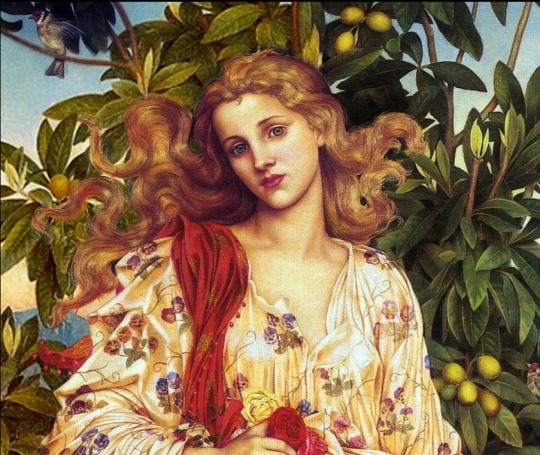
Painting by: Evelyn De Morgan, 1894, Flora.
Her spring and flower associations brought forth symbols of youth, nature, vegetation, gardens, fertility, sex, desire, transformation, and abundance. Her marriage to the West Winds also contributes to her Springtime associations. With these associations in mind, some offerings that would appease her might include:
┌──❀*̥˚───❀*̥˚─┐
🍊Spring garden fruits and vegetables
💮Pressed and dried flowers
🕯Citrus scented candles
🌼Freshly picked flowers
🌿Hand-made wreaths
🧺Hand-made baskets
🧴Floral Perfumes
👑Flower Crowns
💐Bouquets
🌺Garlands
🫒Olive oil
🍯Honey
🍷Wine
🥛Milk
└───❀*̥˚───❀*̥˚┘
Some activities that you can do in Her honor can include things like planting flowers in the garden, growing seasonal fruits and vegetables, general upkeep of gardens and soils, creating scented cleansing sprays and soaps, making flower crowns and other inspired crafts, writing poetry and prayers dedicated to Her, strolling the countryside, wearing brightly colored outfits, and taking care of the gorgeous Earth we live on today.
Pray to Her for abundance, personal growth, positivity, protection of gardens, and thank Her for bountiful spring fruits and vegetables. She is a very loving goddess and deserves recognition for the many qualities She has brought to my life and to that of others.
Paganpillar
Sources:
Ovid Fasti
https://apercu.store/journal-archive/a-brief-history-of-the-goddess-flora
https://www.vindolanda.com/blog/flora-the-goddess-of-flowers
#roman mythology#greek mythology#Flora#Flora Goddess#chloris#Chloris Goddess#roman paganism#greek paganism#hellenic polythiest#hellenism#polytheism#polytheist#roman deity#roman goddess#greek goddess#greek deity#hellenic deities#deities#deity#Mars#Juno#Ovid#pagan#paganism#Greco-Roman#Greco-Roman mythology#Greco-Roman Pagan#Greco-Roman paganism#greco roman paganism#religio romana
17 notes
·
View notes
Note
Apologies, but what are all of JNRZ family semblances, if possible?
Damn talk about a tall order.
Lucien: Aura can create a sugar like substance.
Charolette: Mind control people based on their level of fear.
Whistler: Sunmon Gremlin familiars.
Flora: Undiscovered.
Yuanbao: Aura explodes into fragmentation based on damage recieved.
Zheng: Can replay voices and conversations he has heard before with his own voice.
24 notes
·
View notes
Text
Primavera and the Love of Hannibal ♥
( @manilovedinosaurs tagging as they had given me this wonderful idea with their question :D )


Uffizi Gallery and seen Primavera over ten times. He could have sat before any painting while Will was chasing him but chose Primavera.
Botticelli's work Primavera is an allegorical tableau. It depicts a scene from classical mythology, where the three Graces dance together. The central figure is the goddess of love, Venus, who stands on the right, surrounded by a retinue of gods, nymphs, and attendants. In the background, the horizon is filled with a scene representing the season of spring. The painting is considered a masterpiece of early Italian Renaissance art.
Primavera would have been a personal painting and would reflect his thoughts and feelings to me. Especially as Hannibal is a man of high-class taste including Renaissance art and Greek mythology. Primavera is a painting from the Italian Renaissance expressing the feeling of love.
There are many theories and ideas on what this painting could mean or represent with its symbolism with the characters. Some are the allegory of spring, humanism during the Renaissance, showing of Neoplatonism, the kindling of love, and the metamorphosis of time.
It is generally agreed among historians that these are the main themes but there are many theories about if there is more. For Hannibal, the main themes I think he sees are the metamorphosis of change, Neoplatonism, and the kindling of love. There are way too many themes in this beautiful painting so I will focus on these themes briefly.
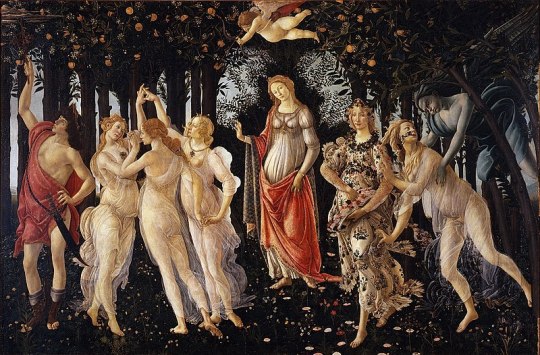
The metamorphosis of time is shown in this painting by combining the ideas of the past and present. It showed how religion and the subject matter of art have changed from Greek mythology to Christianity showing a clash of these. It’s in this sense that it matches the way Hannibal sees the world. He has a complex relationship with God yet sees the parallels of mythology around him. Like the Renaissance, he seems to reveal and understand more the violent and the gritty parts of Christianity. This is considered an uncommon theme for the time this painting is set in the Renaissance. There are several transformations in this painting with the figures of Venus to Mary and Chloris into Flora. In the same way, Hannibal had changed from Il Monstro to the Chesapeake Ripper, Will having his becoming as well.



( Where does the difference between the past and the future come from?
Mine?
Before you and after you.
Yours? )
This painting by looking at it from a broad perspective is about the depiction of the seasons and the changing characters. The painting illustrates a spring scene as the flowers bloom and the seasons change and shows the passing of time in the changing nature of the characters themselves. The image of Zephyrus, the west wind, represents the coming of spring and fertility, while Chloris, the goddess of flowers, holds the nymph Flora as she blossoms in the springtime. Other figures symbolize the different ages of life, symbolizing the changing faces of time. Venus is pictured illustrating the natural cycle of life, which is birth and fertility, which this goddess represents, in combination with the Virgin Mary. With the change that has emerged in Hannibal’s life, there was always a change of women in his life from his past, present, and future.
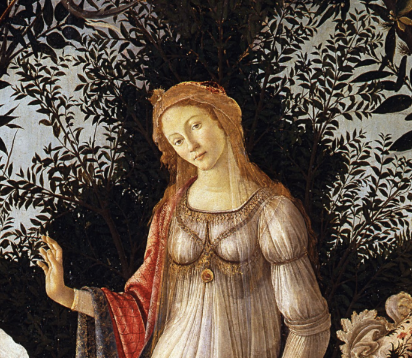

She is depicted with the themes associated with the Virgin as being visibly pregnant, dressed modestly, and hand raised like in the annunciation. The Venus/Virgin Mary is represented in every woman he’s encountered. Bedelia is his present, Mischa and Chiyoh are his past and Abigail is his future. It is also paralleled with the women WIll has met in his life, (Alana, Abigail, Margot). Yet with meeting these women, they have begun to combine and blur more into each other with time The women in his life change just like the seasons, yet Will is the only person he wants to stay with. Hannibal has seen this painting as a young man and now as a man in his late forties. He has changed with time and with the meeting of Will Graham.
(Where does the difference between the past and the future come from?
Mine?
Before you and after you.
Yours?
It's all starting to blur.
Mischa.
Abigail.
Chiyoh.)

He visited Florence with Will and without Will. WIll in that way represents the change Hannibal saw in himself and the change he wanted to cause in Will. Like Zephyrus, he wants to change Chloris and elevate her in the name of love to Flora. He wanted Will to transform into the person he should be, into the person Hannibal envisions him to be. He comes to Florence in hopes of a fresh start and in a way to forget the kindling of the love he shared with Will. As with the final, Hannibal left heartbroken wanting to have shown Will many things about himself and the world. With every turn and step, Hannibal could never truly be free or forget Will as he did with others. The figures of Zephyr, the personification of the west wind, and Chloris symbolize the romantic pursuit and connection. Zephyrus's gentle touch as he holds Chloris’ hand depicts a tender and loving moment between them as they begin their journey together are the centers of attention in the painting's narrative of romantic love. Zephyr's romantic pursuit of Chloris, portrayed by his touch, represents the initial connection and attraction between the two. This scene reflects the idea that love often blossoms unexpectedly, resembling the way the wind blows swiftly and suddenly without warning. This romantic chase is a representation of the deep emotional connection between the two, capturing the raw passion and determination in their pursuit of love.


It reflects the Renaissance emphasis on Humanism, particularly in its portrayal of the kindling of love. During this period, Humanism emphasized the importance of human potential and individual experience. The painting illustrates a moment of blossoming love, with The themes of love and fertility in the painting reflecting the Humanist focus on the individual's emotional and physical well-being and the celebration of natural beauty and desire. Hannibal in a way was always for expressing his nature and that violence was a part of it and believed to be natural. He believed there was nothing wrong with expressing oneself in this manner believing it to be biblical. Many scenes in the Renaissance have gory scenes in the Bible or mythology and love can be attributed during or before the scene. He thinks of violence and love to be parallel to each other.
(You dropped your forgiveness, Will.
You forgive how God forgives.
Would you have done it quickly?
Or would you have stopped to gloat?
Does God gloat?
Often.)

He is the foil to Hannibal, in more ways than one. They are conjoined, yet not similar. The love and understanding they share are as natural as the coming of spring. They are as conjoined as the themes of violence and love in Renaissance art, neither can exist without the other. It is a tango of both desire and passion with these themes. Violence and love share a strange connection in life and literature. While they appear to be complete opposites, they coexist in an unusual dance of power and desire. This push-pull relationship is a raw expression of human emotion on the most fundamental level. It is in the very being of the relationship between Hannibal Lecter and Will.
He is the Clrois to his Zephyrus.
Patrocules to his Achilles.
Love to his Violence.
#nbc hannibal#hannibal lecter#hannibal#hannigram#sandro botticelli#will graham#nbc hannigram#murder husbands#hannibal nbc#uffizi#hugh dancy#mads mikkelsen#mizumono#hannibal x will#hannibal tv show#hannibal season three#hannibal fandom#hannibal analysis#quackerofoatz#Botticelli#Primavera#italian renaissance#Zephyr#Chloris#greek mythology#uffizi gallery#hannibal meta#hannibal parallels#asks open#ask me anything
89 notes
·
View notes
Text
On May day and the first day of Elriel month I want to share a greek/Roman couple that has Elain and Azriel vibe 🥰
Flora and Zephyrus: Spring Romance
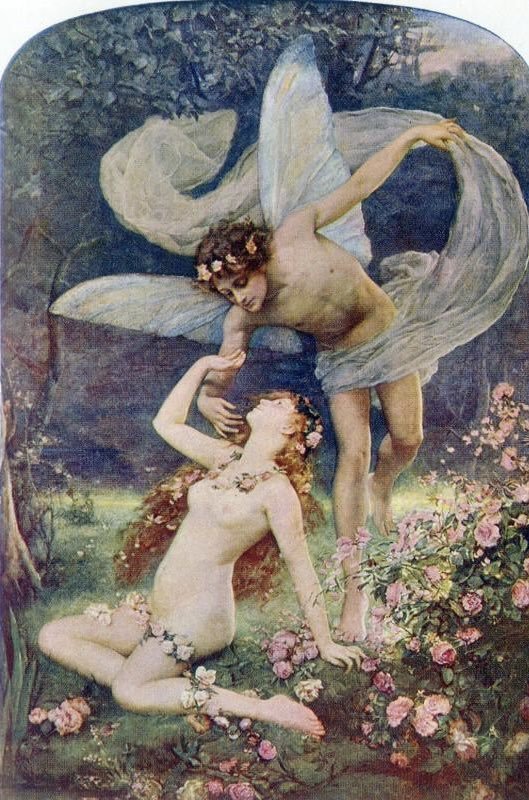
Chloris was a beautiful nymph in the Elysian Fields who caught the attention of Zephyrus, the god of the west wind. They ended up falling in love and marrying. As a wedding gift, he filled her fields with flowers, which were said to be roses and violets, the same flowers that Feyre painted on Elain's drawer.
Through this union, Chloris became Flora, the goddess of flowers, spring, and fertility. She has jurisdiction over flowers, spreading their seeds all over the Earth, while Zephyrus, as the west wind, brings the rain that grows her flowers. Like every mythological couple, they complement each other, similar to the way Elain and Azriel's symbolism complements each other ; life/death, light, and Shadows
Zephyrus was depicted as a handsome winged man, while Flora, known for her beauty, was said to breathe roses as she spoke.
One of my favorite myths is the creation of the rose, the flower associated with Elain in the series : While Flora was wandering in the woods, she found a lifeless, beautiful nymph. Saddened by her death, she transformed her into a rose so that her beauty would become eternal. Flora summoned her friends: Aphrodite, the goddess of love; Ares, the god of war; and Dionysus, the god of wine. Aphrodite gave the rose beauty, Dionysus offered nectar to give it a sweet scent, and Ares provided thorns to protect it. Zephyrus then blew away the clouds to allow the sun to shine through, helping the rose to bloom.
The Roman festival Floralia honored Flora and symbolized the cycle of life, death, and rebirth. Many scholars believe that this festival was the inspiration for the May Day festival.

Happy Elriel Month ❤️
66 notes
·
View notes
Text

The Birth of Venus (1483-1485) 🎨 Sandro Botticelli 🏛️ Uffizi Gallery 📍 Florence, Italy
The painting was commissioned by Lorenzo di Pierfrancesco de’Medici, a cousin of Lorenzo the Magnificent. The theme was probably suggested by the humanist Poliziano. It depicts Venus born from the sea foam, blown by the west wind, Zephyr, and the nymph, Chloris, towards one of the Horai, who prepares to dress her with a flowered mantle.
This universal icon of Western painting was probably painted around 1484 for the villa of Castello owned by Lorenzo di Pierfrancesco de 'Medici. Giorgio Vasari saw the work there in the mid-sixteenth century – along with Botticelli’s other well-known Primavera – and described it precisely as "showing the Birth of Venus." The old idea that the two Botticelli masterpieces were created for the same occasion, in spite of their substantial technical and stylistic diversity, is no longer accepted. However, rather than a birth, what we see is the goddess landing on the shore of her homeland, the island of Cyprus, or on Kithera. The theme, which can be traced back to Homer and to Ovid’s Metamophoses, was also celebrated by the great humanist Agnolo Poliziano in the poetic verses of his Stanze. The Venus of the Uffizi is of the “Venus pudica” type, whose right breast is covered by her right hand and billowing long blond hair partially shrouds her body. The goddess stands upright on a shell as she is driven towards the shore by the breeze of Zephyrus, a wind god, who is holding the nymph, Chloris. On the right is the Hora of springtime, who waits to greet Venus ashore with a cloak covered in pink flowers.
The seascape, stunning for its metaphysical tone and almost unreal quality, is illuminated by a very soft, delicate light. Like Botticelli’s other masterpiece, Pallas and the Centaur, the Birth of Venus is painted on canvas - fairly unusual for its time - using a technique of thin tempera, based on the use of diluted egg yolk, which lends itself particularly well to give the painting that aspect of extraordinary transparency, which brings to mind the pictorial quality of a fresco. The figure recalls classical sculpture and is very similar to the famous Medici Venus found in the Uffizi, which the artist certainly knew. The real meaning of this dreamlike vision is still under scholarly debate and investigation but is undoubtedly linked with the Neo-Platonic philosophy, widely cultivated in the Medici court.
Like the Primavera, the Birth of Venus is also associated with the concept of Humanitas,or virtuous Humanity, a theory developed by Marsilio Ficino in a letter to the young Lorenzo. According to the interpretation by Ernst Gombrich, the work depicts the symbolic fusion of Spirit and Matter, the harmonious interaction of Idea and Nature. Nevertheless, the interpretations of this painting of extraordinary visual impact are numerous and diverse. The divine ethereal figure has been viewed as an allegorical representation of Humanitas upon her arrival to Florence, while the nymph holding out the cloak of flowers for the goddess may perhaps be identified as Flora, the same depicted in this masterpiece’s “twin”, the Primavera, where she may be seen instead as the personification of the city of Florence. From this work emerges clear evidence of Botticell’s strive to reach perfection of form that could rival with classical antiquity. It is for this reason that the humanist Ugolino Verino in his work Epigrammata, presented in 1485 to the King of Hungary, Matthias Corvinus, likened the Florentine painter to the legendary Apelles of Ancient Greece.
#The birth of Venus#Sandro Botticelli#Le Gallerie Degli Uffizi#Uffizi Gallery#Florence#Italy#La nascita di Venere#painting#tempera on panel#art#artwork#art history#Early Renaissance#Italian Renaissance#1483#1484#1485#italian#Renaissance
38 notes
·
View notes